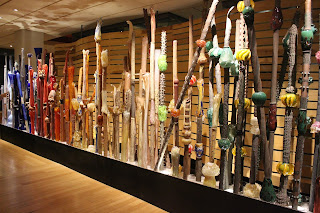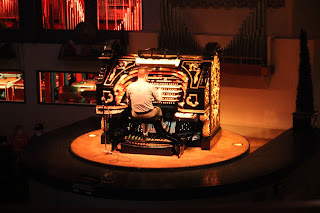On Tuesday, February, 11th, we walked to breakfast at the Arizona Bread Company. Not great.
Then we drove to Canaan in the Desert. This is a convent, begun in the 1950s by an order of German Protestant nuns. They have a nice garden, with a sort of Stations of the Cross (though not exactly), a set of sculpted tableaux for meditation on Christ's passion, death and resurrection.
Then we went to the Heard Museum, in downtown Phoenix. This is the preeminent museum of American Indian art. First, we had lunch at the museum café, which specializes in cuisine based on Native American dishes. It was very good. Each table had a small piece of art.
That day, there was a combined exhibition of baskets made by Indians selling to tourists at Yosemite National Park, mostly about a century ago, along with "paintings" of Yosemite that the famous artist David Hockney made on an I-Pad, then printed off in large format.
Then we drove to Canaan in the Desert. This is a convent, begun in the 1950s by an order of German Protestant nuns. They have a nice garden, with a sort of Stations of the Cross (though not exactly), a set of sculpted tableaux for meditation on Christ's passion, death and resurrection.
Then we went to the Heard Museum, in downtown Phoenix. This is the preeminent museum of American Indian art. First, we had lunch at the museum café, which specializes in cuisine based on Native American dishes. It was very good. Each table had a small piece of art.
That day, there was a combined exhibition of baskets made by Indians selling to tourists at Yosemite National Park, mostly about a century ago, along with "paintings" of Yosemite that the famous artist David Hockney made on an I-Pad, then printed off in large format.
There was an exhibit relating to the Indian Schools. Indigenous children were taken from their
parents and carried off to boarding schools, where they were trained, in
essence, to be white people, with disastrous effect on tribal culture, to say
nothing of the effect on the children themselves.
The most interesting piece at the Heard is a sort of
fence, made of glass, ceramics, etc., called “Indigenous Evolution.” Strange, but somehow exhilarating.
Then we headed off to Mesa, to Organ Stop Pizza. This is a large space, laid out like a German
beer hall, with long tables on the main floor and more on the mezzanine. At the front is a thrust stage, behind that,
a windowed wall displaying the innards of a huge theater organ. When a set begins, the organ console and
organist slowly rise out of the stage, playing some show tune or pop song or
anything else that would please the large crowd, who have put in their pizza
orders in the lobby and are waiting for their number to light up on the boards high
up on the side walls of the auditorium. Every
once in a while, the organist announces birthdays. He also steps to the front of the stage,
where he takes request slips. There are
lots of special effects—drums, gongs, whistles, duck calls, dancing cat
puppets, the American and Canadian flags (for the respective national anthems—a
fair number of people stood to sing “O, Canada”), and lighting effects—eerie for
“Phantom of the Opera.” It’s kind of
schlocky, but great fun, and the pizza is pretty good. The organist was terrific--I was with someone who should know, and she agreed.






























No comments:
Post a Comment